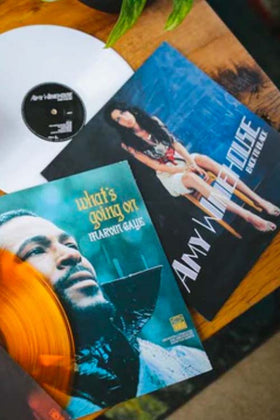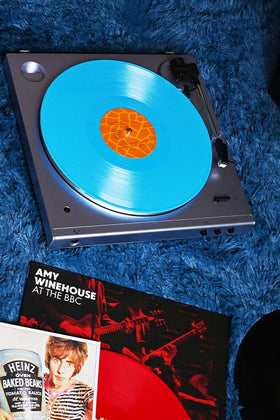Are Colored Vinyl Records Rare? Here's Why You Should Collect Them
In the modern age of music, some scoff at the idea of listening to vinyl records. Of all of the technology available for listening to music today, vinyl isn’t always seen as the most high-tech or up-to-date medium to choose. But behind those humble vinyl records, there is a magic sonic experience that other forms of music simply just can’t match. Put a record on a turntable for the first time, and we guarantee you’ll experience the immersiveness of the format.
As vinyl has seen a massive resurgence over the past few decades, many artists and musicians have used records to express themselves in ways that aren’t possible with traditional forms of digital music. Instead of being limited to whatever bands and musicians could display on their digital streaming service or online distribution centers, vinyl records allow artists to incorporate a truly tactile and hands-on experience into their music.
Records have cultivated a unique space for many artists to create and display unique designs that their listeners and fans can interact with using their eyes and hands just as much as their ears. Many musicians have put lots of time and energy into producing vinyl records that are as visually stimulating and exciting as possible. While traditional black vinyl records are still the most common type of record, colored vinyl is starting to become one of the most popular alternative varieties of LP on the market.
Below, you’ll learn what colored vinyl is and why collecting them can be one of the best habits to form as a music lover.
Are Colored Vinyl Records Rare?
When you think of a vinyl record, the first picture that pops into your head is likely a large black disc. While the classic black LP is timeless and certainly looks phenomenal, a conventional vinyl record isn’t exactly eye-catching. If it weren’t for the label on a vinyl record, it would be tough to differentiate your favorite albums from each other – they’d essentially all look the same.
That’s why colored records have become so popular – they add an entirely new level of uniqueness to the record-collecting and listening experience. With modern methods of production, there are virtually infinite color and pattern combinations that can be used instead of traditional black vinyl. Records can be made with splatter designs, colors inside of colors, marbled designs, transparent materials, and countless other options. Vinyl producers keep finding new exciting ways to make vinyl designs more engaging and eye-catching than ever, and the trend is showing no signs of slowing down.
The best part about colored vinyl? You’ve got the potential to end up with a completely unique record that no one else has. Depending on the type of design that a band or artist chooses, a colored LP can end up having attributes that set it apart from every other record in the world. Splatter designs, for example, never print exactly the same way twice, which means that even if there are hundreds of records in the same production line, they will all end up being unique.
Even in production runs made uniformly, colored vinyl records are much more rare and unique than almost any other kind of record. Standard black vinyl records are still the most common kind of record, which means that any colored record you get is likely much rarer than any black record.
Why You Should Collect Colored Vinyls
While rarity might intrigue you as a collector, there is still a fair chance that the rarity of an album alone may not be enough to convince you to get a colored record. If that’s the case, then worry not – there are countless more reasons to invest in colored records. The value of colored records goes far beyond the obvious, as you’ll discover in the paragraphs below.
Supporting Your Favorite Artists
When an artist chooses to release a specially designed vinyl record, they’ve created a unique opportunity for you as a fan to support them financially.
In the modern world of music, it’s challenging to make a living off of the royalties generated by digital streaming platforms. Very few artists can sustainably live off streaming alone, even if they have tens of thousands of dedicated listeners. While physical music sales used to create a much larger income for artists, the streaming age has made listening much more inexpensive for fans – but also less capable of supporting artists.
Listening to an album on a streaming service will only give an artist you love a couple of cents at best, but buying a record can give them upwards of three hundred times the money that streaming will. If there are any artists you truly love, check to see if they have any special-edition colored records available in our online shop. It's the best way to show your favorite bands and musicians some love.
Colored Records Have a Better Resale Value
Due to their rarity compared to more traditional kinds of records, colored vinyl records generally have a much higher resale value as time goes on. Of course, very few people buy records with the sole purpose of selling them later. Still, the reality is that these limited edition kinds of records retain their monetary value much more effectively than traditional records do.
For collectors and enthusiasts, colored vinyl records can quickly become sought-after pieces of musical history. If you hold on to your colored LPs for long enough, you’re likely to have no trouble selling them for a pretty penny once they’ve gone vintage.
In addition, colored records are often produced in limited quantities, which means they will also have a much more exciting “rarity factor” to them. This rarity factor can still appeal to fans of an artist years down the road – there are few things more exciting than getting a limited-edition vinyl record that was made years, or even decades, ago.
Decorative Purposes
Of course, one of the primary reasons to get a colored vinyl record is simply because they look awesome. Colored LPs add a new dimension to the aesthetic value of your record collection in several ways.
They look fantastic while spinning on your turntable, they often come in limited-edition packaging, and they’re fascinating to look at while they’re on display. You can’t ask for much more than that from a collectible record.
Conclusion
While colored records may seem like just another fad, the reality is that they’re here to stay. On top of the aesthetic appeal, rarity, and increased resale value, there are plenty of other perks to adding these very special records to your collection. Getting a special piece of physical media like a colored record is one of the best ways to support your favorite artists, and it’s also a unique way to invest in musical history. After all, chances are that there will never be a batch of records produced again that are quite like the colored LPs in your collection.
If you’re interested in learning more about collecting and listening to vinyl records, feel free to take a look around our blog. There, you’ll find a wealth of helpful information about turntables, records, audio gear, and much more.
Sources:
Why Vinyl Is More Important to Artists Than Streaming, Touring, and T-Shirts... | Digital Music News
Spin Me Round: Why Vinyl is Better Than Digital | Aesthetics for Birds
Are Colored Vinyl Records More Valuable Than Black Vinyl? | Story Console




